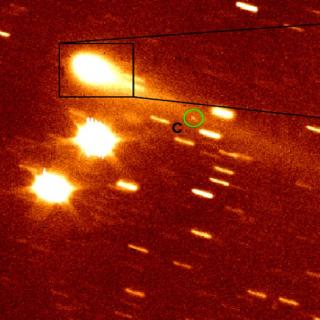Bibcode
Ortiz, J. L.; Kretlow, M.; Schnabel, C.; Morales, N.; Flores-Martín, J.; Sánchez González, M.; Casarramona, F.; Selva, A.; Perelló, C.; Román-Reche, A.; Alonso, S.; Rizos, J. L.; Gonçalves, R.; Castillo, A.; Madiedo, J. M.; Martínez Sánchez, P.; Fernández Andújar, J. M.; Maestre, J. L.; Smith, E.; Gil, M.; Pelenjow, V.; Moral Soriano, S.; Martí, J.; Luque-Escamilla, P. L.; Casas, R.; Delgado Casal, J.; Rovira, J.; Aceituno, F. J.; Dekert, V.; Farfan, R. G.; de Ory Guimerá, V.; Serrano Estepa, J.; Jehin, E.; Ferrais, M.; Alarcon, M. R.; Licandro, J.; Serra-Ricart, M.; Gutiérrez, P. J.; Kilic, Y.; Leiva, R.; Santos-Sanz, P.; Duffard, R.; Fernández-Valenzuela, E.; Vara-Lubiano, M.; Alvarez-Candal, A.; Rommel, F. L.
Referencia bibliográfica
Monthly Notices of the Royal Astronomical Society
Fecha de publicación:
2
2024
Número de citas
3
Número de citas referidas
2
Descripción
On 2023 December 12, the star α Orionis will be occulted by asteroid (319) Leona. This represents an extraordinary and unique opportunity to analyse the brightness distribution of Betelgeuse's photosphere with extreme angular resolution by studying light curves from different points on Earth and at different wavelengths. Here we present observations of another occultation by asteroid Leona, on 2023 September 13, whose goal was to determine Leona's projected shape and size in preparation for the December 12th event and its interpretation. The occultation campaign was highly successful with 25 positive detections from 17 different sites and a near miss. The effective diameter in projected area derived from the positive detections was 66 ± 2 km using an elliptical fit to the instantaneous limb. The body is highly elongated, with dimensions of 79.6 ± 2.2 km × 54.8 ± 1.3 km in its long and short axis, respectively, at occultation time. This result, in combination with dense time series photometry of Leona that we recently obtained, together with archival sparse photometry, allowed us to predict the angular size of the asteroid for the Betelgeuse event and to simulate the expected brightness change. Also, an accurate position coming from the occultation is provided, to improve the orbit of Leona.
Proyectos relacionados

Pequeños Cuerpos del Sistema Solar
Este Proyecto estudia las propiedades físicas y composicionales de los llamados pequeños cuerpos del Sistema Solar, que incluyen asteroides, objetos helados y cometas. Entre los grupos de mayor interés destacan los objetos trans-neptunianos (TNOs), incluyendo los objetos más lejanos detectados hasta la fecha (Extreme-TNOs o ETNOs); los cometas, y
Julia de
León Cruz